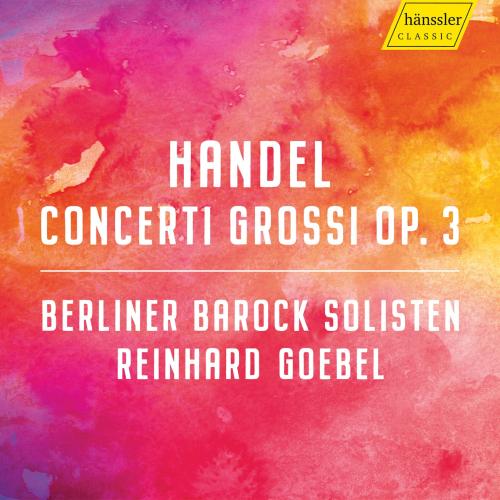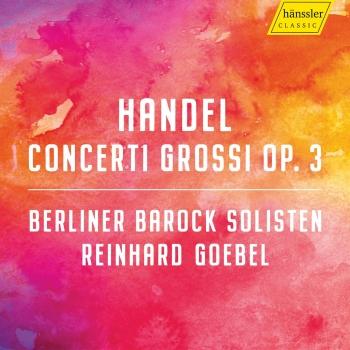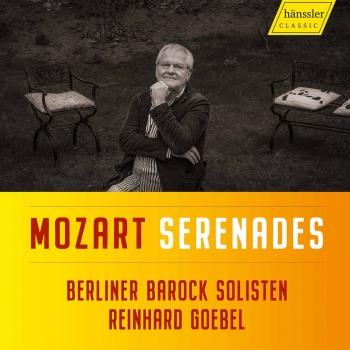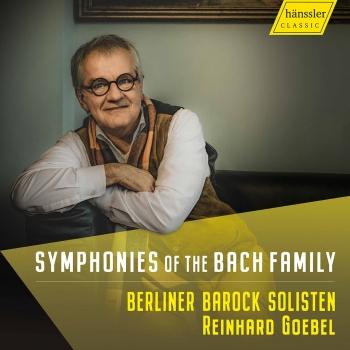
Handel: Concerti Grossi, Op. 3 Berliner Barock Solisten & Reinhard Goebel
Album info
Album-Release:
2019
HRA-Release:
14.06.2019
Label: haenssler CLASSIC
Genre: Classical
Subgenre: Chamber Music
Artist: Berliner Barock Solisten & Reinhard Goebel
Composer: Georg Friedrich Händel (1685-1759)
Album including Album cover Booklet (PDF)
- Georg Friedrich Händel (1685 - 1759): Concerto Grosso in B-Flat Major, Op. 3 No. 1, HWV 312:
- 1 Concerto Grosso in B-Flat Major, Op. 3 No. 1, HWV 312: I. Allegro 02:38
- 2 Concerto Grosso in B-Flat Major, Op. 3 No. 1, HWV 312: II. Largo 04:42
- 3 Concerto Grosso in B-Flat Major, Op. 3 No. 1, HWV 312: III. Allegro 01:18
- Concerto Grosso in B-Flat Major, Op. 3 No. 2, HWV 313:
- 4 Concerto Grosso in B-Flat Major, Op. 3 No. 2, HWV 313: I. Vivace - Grave 01:51
- 5 Concerto Grosso in B-Flat Major, Op. 3 No. 2, HWV 313: II. Largo 02:35
- 6 Concerto Grosso in B-Flat Major, Op. 3 No. 2, HWV 313: III. Allegro 02:14
- 7 Concerto Grosso in B-Flat Major, Op. 3 No. 2, HWV 313: IV. Menuett 02:26
- 8 Concerto Grosso in B-Flat Major, Op. 3 No. 2, HWV 313: V. Gavotte 03:20
- Concerto Grosso in G Major, Op. 3 No. 3, HWV 314:
- 9 Concerto Grosso in G Major, Op. 3 No. 3, HWV 314: I. Largo e staccato - Allegro 03:05
- 10 Concerto Grosso in G Major, Op. 3 No. 3, HWV 314: II. Adagio 00:50
- 11 Concerto Grosso in G Major, Op. 3 No. 3, HWV 314: III. Allegro 04:08
- Concerto Grosso in F Major, Op. 3 No. 4a, HWV 315:
- 12 Concerto Grosso in F Major, Op. 3 No. 4a, HWV 315: I. Andante - Allegro 06:12
- 13 Concerto Grosso in F Major, Op. 3 No. 4a, HWV 315: II. Andante 01:38
- 14 Concerto Grosso in F Major, Op. 3 No. 4a, HWV 315: III. Allegro 01:33
- 15 Concerto Grosso in F Major, Op. 3 No. 4a, HWV 315: IV. Minuetto 05:56
- Concerto Grosso in D Minor, Op. 3 No. 5, HWV 316:
- 16 Concerto Grosso in D Minor, Op. 3 No. 5, HWV 316: I. — 01:36
- 17 Concerto Grosso in D Minor, Op. 3 No. 5, HWV 316: II. Allegro 02:31
- 18 Concerto Grosso in D Minor, Op. 3 No. 5, HWV 316: III. Adagio 01:22
- 19 Concerto Grosso in D Minor, Op. 3 No. 5, HWV 316: IV. Allegro ma non tropüpo 01:42
- 20 Concerto Grosso in D Minor, Op. 3 No. 5, HWV 316: V. Allegro 02:52
- 21 Concerto Grosso in D Major, Op. 3 No. 6, HWV 317: I. Vivace 03:00
- 22 Concerto Grosso in D Major, Op. 3 No. 6, HWV 317: II. Allegro 03:35
- Concerto Grosso in F Major, Op. 3 No. 4b (Attrib. Handel):
- 23 Concerto Grosso in F Major, Op. 3 No. 4b (Attrib. Handel): I. Largo 01:41
- 24 Concerto Grosso in F Major, Op. 3 No. 4b (Attrib. Handel): II. Allegro 03:14
- 25 Concerto Grosso in F Major, Op. 3 No. 4b (Attrib. Handel): III. Largo 03:30
- 26 Concerto Grosso in F Major, Op. 3 No. 4b (Attrib. Handel): IV. Allegro 01:41
Info for Handel: Concerti Grossi, Op. 3
In the "Concerti Opus 3" Handel prescribes the standard orchestra for the late Baroque era: two oboes, strings and a continuo group. However, we learn from the solo-tutti supplements and the court account books that the ensemble was in fact larger and more polyphonic than the original, simple manuscript and the subsequent modern score suggest: occasionally the number of bassoons was equal to that of the cellos, though they were only given solo parts when they were disengaged from the bass group of instruments. It was common practice too – not in Cöthen or Hamburg, it is true, but certainly in Dresden, Paris and London – for at least two if not three oboists to be assigned to each part, these being augmented by special instruments such as the old-style recorder and the new transverse flute, and after 1750 the Clarinet. The Concerto Opus 3, no. 1 requires a total of six obbligato wind instruments (two oboes, two recorders and two bassoons) and is therefore no "odd man out" composition, but rather reproduces fairly accurately the minimum range that an orchestra at Handel's disposal would have comprised: in the middle movement of the concerto, two ripieno oboists take up recorders, and then return to the fold as oboists afterwards.
Berliner Barock Solisten
Reinhard Goebel, direction
Berliner Barock Solisten
There are plenty of early music ensembles making the rounds nowadays. Many of them play quite appealingly, and some of them exhibit a topnotch standard of musicianship. However, only few of them display a level of artistic mastery akin to that of the Berliner Barock Solisten, founded in 1995 by Rainer Kussmaul and other prominent members of the Berlin Philharmonic. These musicians have joined their talents in creating a unique approach to the musical works of the 1600’s and 1700’s.
The “Berlin Baroque Soloists” not only do true honor to their name, since each one of them is a true bravura player. They also play on old but modernized instruments, using bows from different periods (depending on the work they are performing). Such flexibility, along with the ensemble’s exceptional homogeneity and the presence of leading early music soloists within its ranks, have contributed towards establishing this group’s leading position on the international scene. Just as their stylistic assuredness that permits them to practically “transfer” compositions from ages long past into our day and age, without damaging the historical veneer that covers them, nor ignoring the historical period in which they were written. Old sounds are thus heard with fresh ears. Works of the past are reconsidered in a new light – resulting in an interpretation that can be regarded as modern, yet certainly not ‘modernistic’; a style that spans the ages, fully valid both then and now. The Berliner Barock Solisten are capable of applying this approach to a number of composers, be it the creations of Italian masters, or the music of Telemann (for whom they have a special liking), that of Johann Sebastian Bach or of his contemporaries. For each individual piece they find a unique, inimitable tone.
Consistently applied over the last sixteen years, this unique approach to performance has led to a stupendous degree of recognition and approval on the part of audiences and critics alike. On concert podiums from Tokyo or Seoul to Berlin, from London to New York, from Paris to Shanghai as well as in a number of smaller towns – everywhere the Berliner Barock Solisten perform, they have left an indelible musical mark, ensuring that the ranks of their true fans are continually enlarged. Their programs are documented on numerous CD recordings whose exceptional quality has been widely acknowledged by music critics. Thus, the Berliner Barock Solisten were awarded a Grammy for their 2005 release of Bach cantatas, along with the German recording industry’s Echo Classic Prize for two successive CD’s featuring solo concertos by Telemann.
Such success can also be attributed to the outstanding artists who performed with the ensemble: singers such as Thomas Quasthoff, Christine Schäfer, Dorothea Röschmann, Christiane Oelze, Marc Padmore and Michael Schade, wind soloists of the likes of Emmanuel Pahud, Jacques Zoon, Albrecht Mayer, Jonathan Kelly, Maurice Steger, Michala Petri and Reinhold Friedrich, violinists such as Frank-Peter Zimmermann, Daishin Kashimoto and Daniel Hope as well as harpsichordist Andreas Staier.
Booklet for Handel: Concerti Grossi, Op. 3












